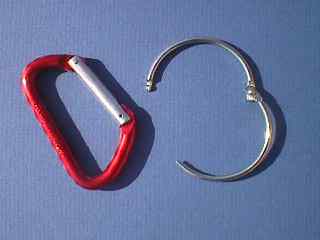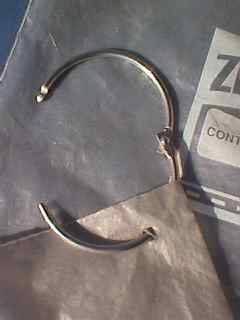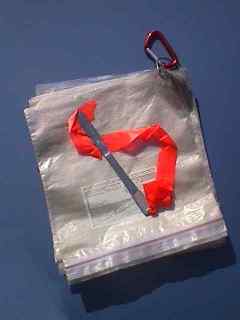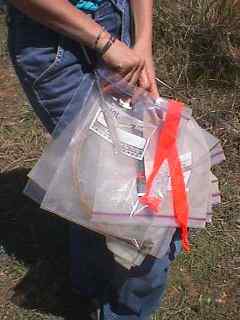Technique for carrying botanical plant samples
There are many methods for handling plant samples you collect in the field. Here is a “recipe” for equipment that costs little to assemble. Many botanists have found this useful.
As with any recipe, you can vary it to your taste.
The ingredients are few:
- Ziplock bags
- A miniature “carabiner” keyclip
- A large binder ring
- A kitchen table knife
- Colored plastic surveyor’s ribbon
- Duct tape
Many botanists are familiar with using plastic bags to hold plants. This idea make everything more hands-free.
Get gallon ziplock bags, available at any grocery store. (Depiction of a certain brand does not imply endorsement of that brand) Bags without the slider work best. The sliders get caught on things.
For the mini-biner, you may want to choose a bright color, to spot easier in the brush.
Binder rings are available from office supply stores. A binder ring is hinged, and the open ends lock together. Notice that this is not the same as a keyring. A split keyring would be very difficult to use for this.
Some shower curtain rings are the same design as binder rings, but you can usually buy binder rings in fewer quantity.
To assemble, simply punch the binder ring through a corner of each bag.
You may want to punch through the bottom corners of all bags except one. That way, most openings will hang down.
The one bag pointing up serves as a pouch for equipment such as specimen labels, pens, and collecting tools.
To complete the setup, close the binder ring and clip the mini-biner through.
A handy tool is a table knife, available at any second hand store. Choose a knife constructed in one solid piece.
Of course, a knife like this. does not dig as well as a shovel, nor cut as well as pruning shears. But it’s a good compromise, in lightweight field equipment.
A proper botanical specimen has sufficient root to show if it’s annual or perennial, taprooted or fibrous. Don’t expect a little knife like this to jab in and pop it out. But a few minutes flicking soil away will allow you get enough roots.
A dropped knife will vanish in the brush. To prevent this, mark your knife with colored flagging ribbon.
Wrap duct tape around the handle once first. Then slip in the flagging, and wrap again. That way the flagging won’t come off.
The one bag with opening at the top stands out as the holder for equipment.
Some people prefer all the bags up. They are concerned specimens will fall out, though this does not happen if the bags are zipped shut.
If your protocol uses them, you can pre-load each bag with a label, ready for the specimen.
The unit can hang from a belt loop.
The slick plastic seldom gets tangled and torn as you walk through brush. When bags do wear out, just replace them.
When you collect a plant, simply swing one of the bags up, drop in the sample, and zip the bag shut.
Plants don’t tend to “cook” in the bags unless left lying directly in the sun. However, this can happen quickly. One case to watch out for is sunlight coming through vehicle windows, even while driving with air conditioning on.
You can keep a few un-punched ziplock bags in the equipment pouch for crispy-dry specimens. Carefully insert the plant, add a squirt of water, blow up the bag like a pillow, and zip it shut. By the time you are ready to press, the dry specimen will have softened enough to flatten without crumbling.












